CNA742 - Mental Health Nursing: Care and Recovery Plan for Catherine
VerifiedAdded on 2023/04/06
|21
|3449
|109
Report
AI Summary
This report presents a comprehensive nursing care and recovery plan for Catherine, a patient diagnosed with Bipolar Affective Disorder (BPAD). The plan addresses Catherine's manic symptoms, including excitability, talkativeness, and disrupted self-care. It outlines nursing interventions, rationales for psychotherapeutic and pharmacological procedures, and a detailed home reintegration plan. Key aspects covered include mental state examination, risk assessment, pharmacological interventions like Lithium and Diazepam, and psychotherapeutic approaches such as Cognitive Behavioral Therapy (CBT) and family-focused therapy. The plan emphasizes a multidisciplinary approach involving collaboration with psychotherapists and nutritionists to address Catherine's specific needs, such as improving food intake and managing medication side effects. The report also highlights the importance of family involvement in Catherine's care and reintegration process, focusing on psycho-education and empathetic support from her husband, Greg. The goal is to provide a holistic and effective recovery strategy for Catherine, ensuring her well-being and successful return home.
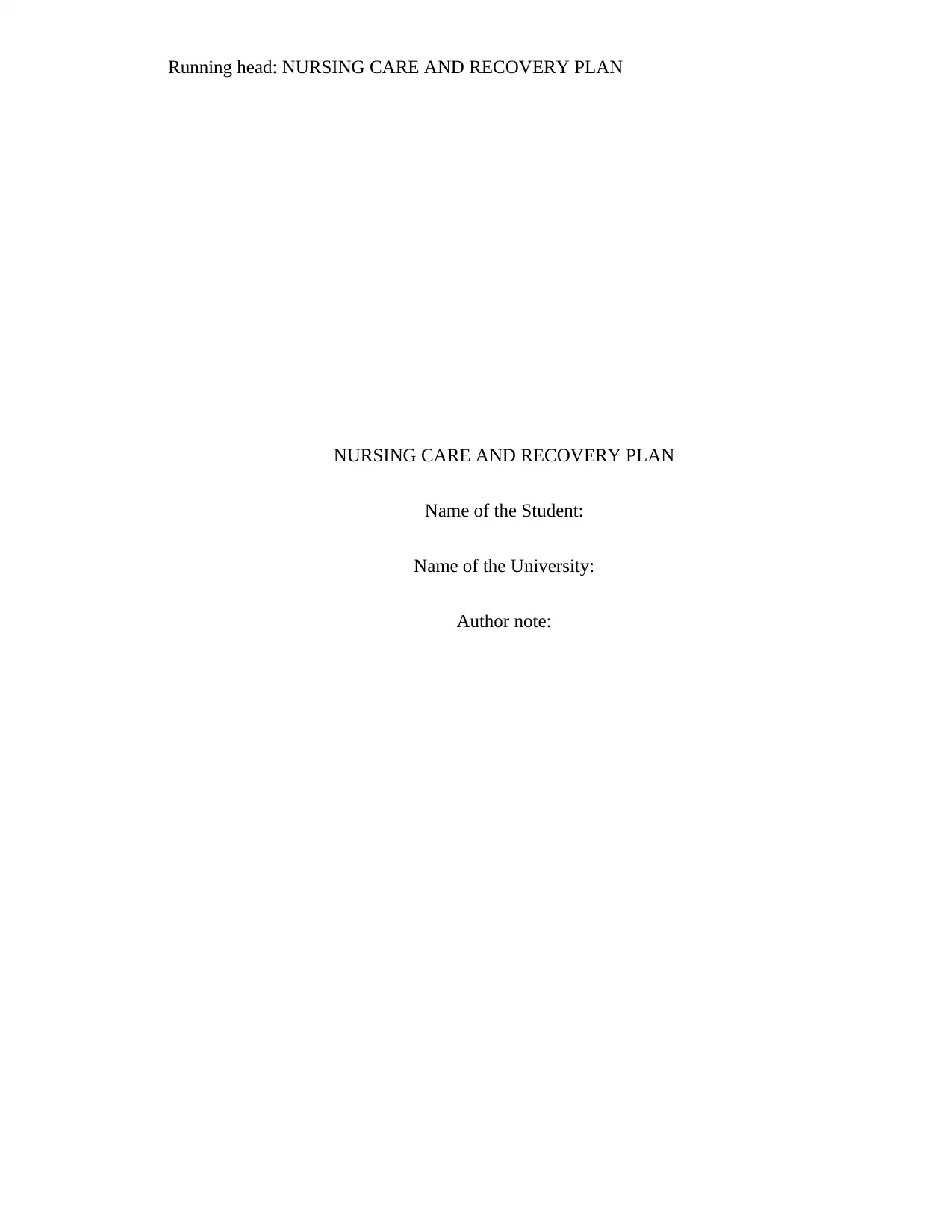
Running head: NURSING CARE AND RECOVERY PLAN
NURSING CARE AND RECOVERY PLAN
Name of the Student:
Name of the University:
Author note:
NURSING CARE AND RECOVERY PLAN
Name of the Student:
Name of the University:
Author note:
Paraphrase This Document
Need a fresh take? Get an instant paraphrase of this document with our AI Paraphraser
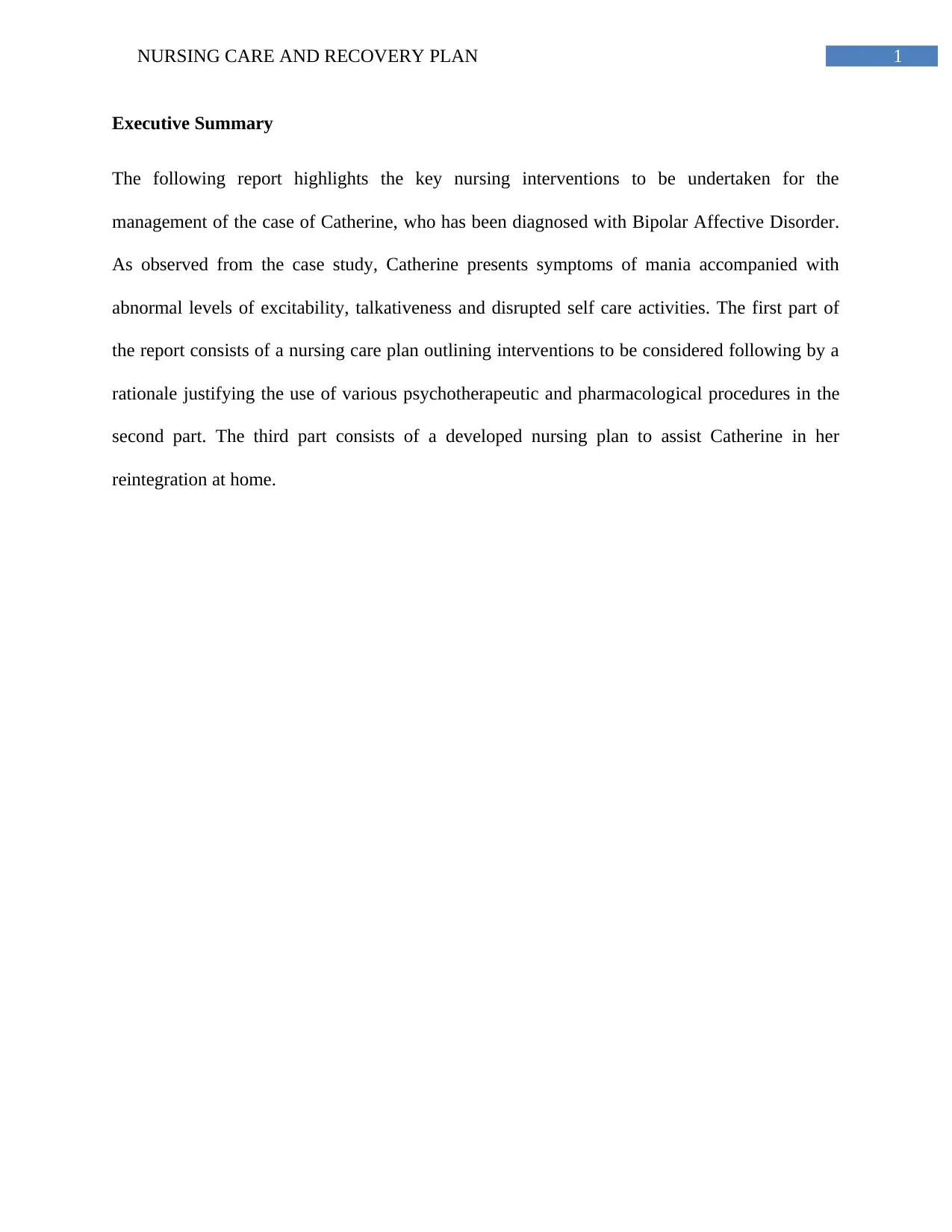
1NURSING CARE AND RECOVERY PLAN
Executive Summary
The following report highlights the key nursing interventions to be undertaken for the
management of the case of Catherine, who has been diagnosed with Bipolar Affective Disorder.
As observed from the case study, Catherine presents symptoms of mania accompanied with
abnormal levels of excitability, talkativeness and disrupted self care activities. The first part of
the report consists of a nursing care plan outlining interventions to be considered following by a
rationale justifying the use of various psychotherapeutic and pharmacological procedures in the
second part. The third part consists of a developed nursing plan to assist Catherine in her
reintegration at home.
Executive Summary
The following report highlights the key nursing interventions to be undertaken for the
management of the case of Catherine, who has been diagnosed with Bipolar Affective Disorder.
As observed from the case study, Catherine presents symptoms of mania accompanied with
abnormal levels of excitability, talkativeness and disrupted self care activities. The first part of
the report consists of a nursing care plan outlining interventions to be considered following by a
rationale justifying the use of various psychotherapeutic and pharmacological procedures in the
second part. The third part consists of a developed nursing plan to assist Catherine in her
reintegration at home.
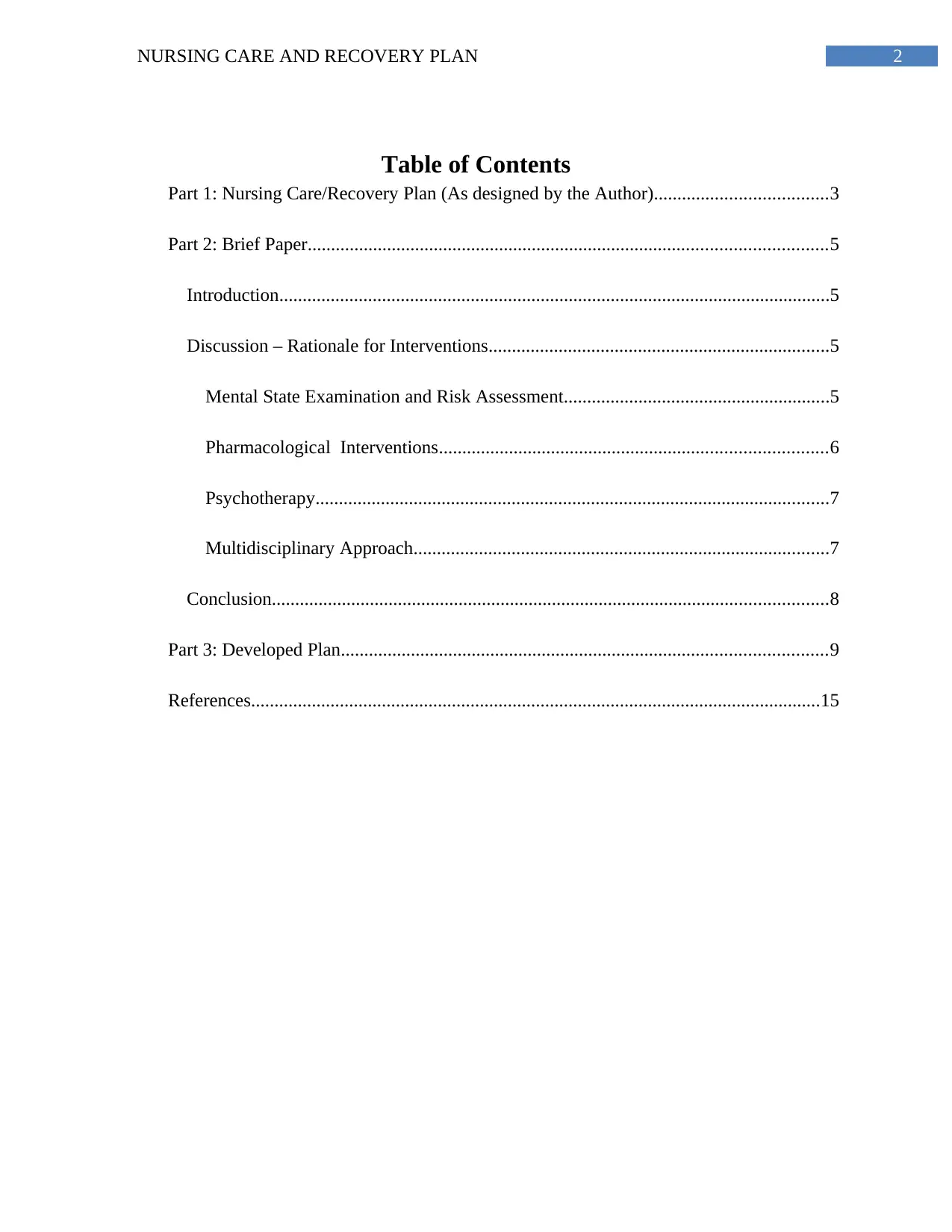
2NURSING CARE AND RECOVERY PLAN
Table of Contents
Part 1: Nursing Care/Recovery Plan (As designed by the Author).....................................3
Part 2: Brief Paper...............................................................................................................5
Introduction......................................................................................................................5
Discussion – Rationale for Interventions.........................................................................5
Mental State Examination and Risk Assessment.........................................................5
Pharmacological Interventions...................................................................................6
Psychotherapy..............................................................................................................7
Multidisciplinary Approach.........................................................................................7
Conclusion.......................................................................................................................8
Part 3: Developed Plan........................................................................................................9
References..........................................................................................................................15
Table of Contents
Part 1: Nursing Care/Recovery Plan (As designed by the Author).....................................3
Part 2: Brief Paper...............................................................................................................5
Introduction......................................................................................................................5
Discussion – Rationale for Interventions.........................................................................5
Mental State Examination and Risk Assessment.........................................................5
Pharmacological Interventions...................................................................................6
Psychotherapy..............................................................................................................7
Multidisciplinary Approach.........................................................................................7
Conclusion.......................................................................................................................8
Part 3: Developed Plan........................................................................................................9
References..........................................................................................................................15
⊘ This is a preview!⊘
Do you want full access?
Subscribe today to unlock all pages.

Trusted by 1+ million students worldwide
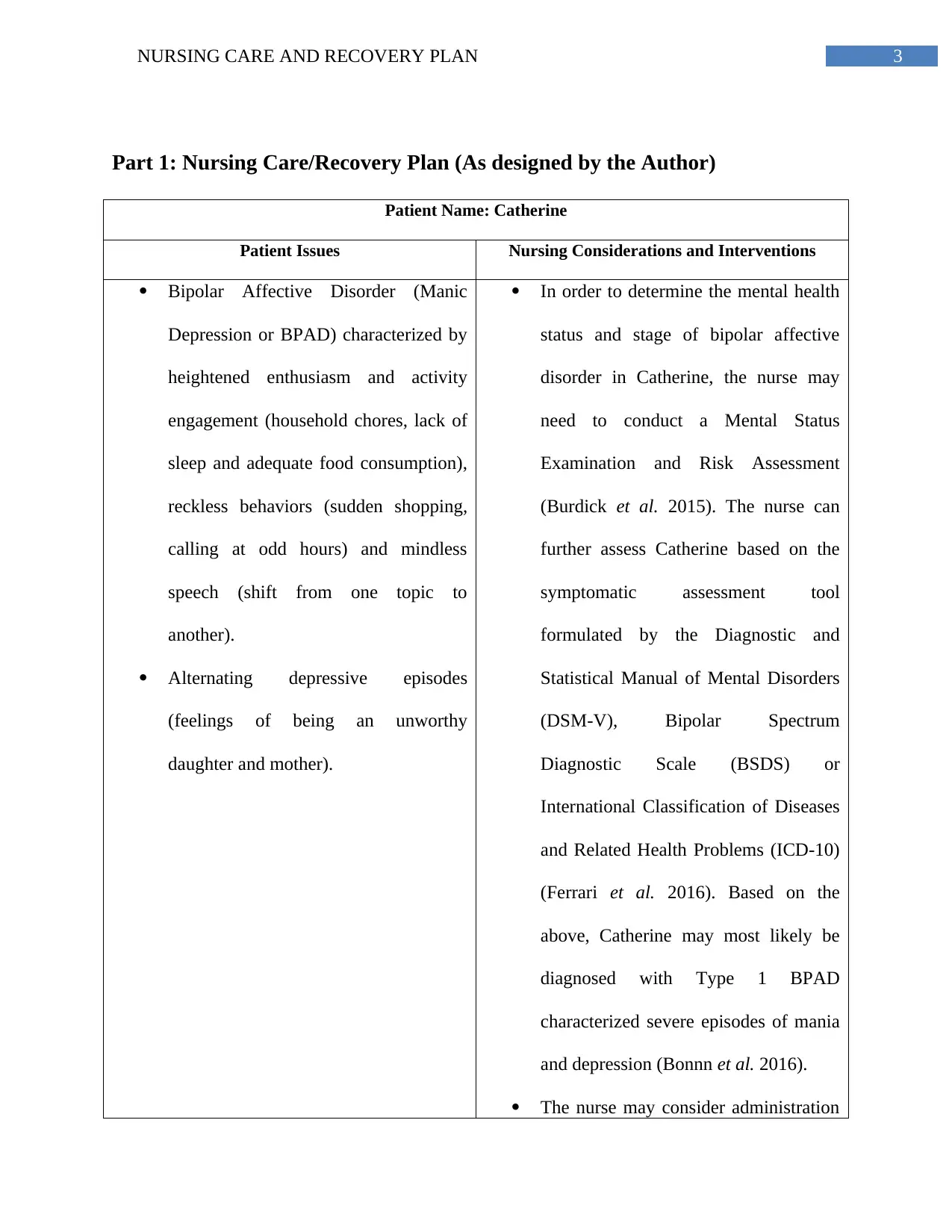
3NURSING CARE AND RECOVERY PLAN
Part 1: Nursing Care/Recovery Plan (As designed by the Author)
Patient Name: Catherine
Patient Issues Nursing Considerations and Interventions
Bipolar Affective Disorder (Manic
Depression or BPAD) characterized by
heightened enthusiasm and activity
engagement (household chores, lack of
sleep and adequate food consumption),
reckless behaviors (sudden shopping,
calling at odd hours) and mindless
speech (shift from one topic to
another).
Alternating depressive episodes
(feelings of being an unworthy
daughter and mother).
In order to determine the mental health
status and stage of bipolar affective
disorder in Catherine, the nurse may
need to conduct a Mental Status
Examination and Risk Assessment
(Burdick et al. 2015). The nurse can
further assess Catherine based on the
symptomatic assessment tool
formulated by the Diagnostic and
Statistical Manual of Mental Disorders
(DSM-V), Bipolar Spectrum
Diagnostic Scale (BSDS) or
International Classification of Diseases
and Related Health Problems (ICD-10)
(Ferrari et al. 2016). Based on the
above, Catherine may most likely be
diagnosed with Type 1 BPAD
characterized severe episodes of mania
and depression (Bonnn et al. 2016).
The nurse may consider administration
Part 1: Nursing Care/Recovery Plan (As designed by the Author)
Patient Name: Catherine
Patient Issues Nursing Considerations and Interventions
Bipolar Affective Disorder (Manic
Depression or BPAD) characterized by
heightened enthusiasm and activity
engagement (household chores, lack of
sleep and adequate food consumption),
reckless behaviors (sudden shopping,
calling at odd hours) and mindless
speech (shift from one topic to
another).
Alternating depressive episodes
(feelings of being an unworthy
daughter and mother).
In order to determine the mental health
status and stage of bipolar affective
disorder in Catherine, the nurse may
need to conduct a Mental Status
Examination and Risk Assessment
(Burdick et al. 2015). The nurse can
further assess Catherine based on the
symptomatic assessment tool
formulated by the Diagnostic and
Statistical Manual of Mental Disorders
(DSM-V), Bipolar Spectrum
Diagnostic Scale (BSDS) or
International Classification of Diseases
and Related Health Problems (ICD-10)
(Ferrari et al. 2016). Based on the
above, Catherine may most likely be
diagnosed with Type 1 BPAD
characterized severe episodes of mania
and depression (Bonnn et al. 2016).
The nurse may consider administration
Paraphrase This Document
Need a fresh take? Get an instant paraphrase of this document with our AI Paraphraser
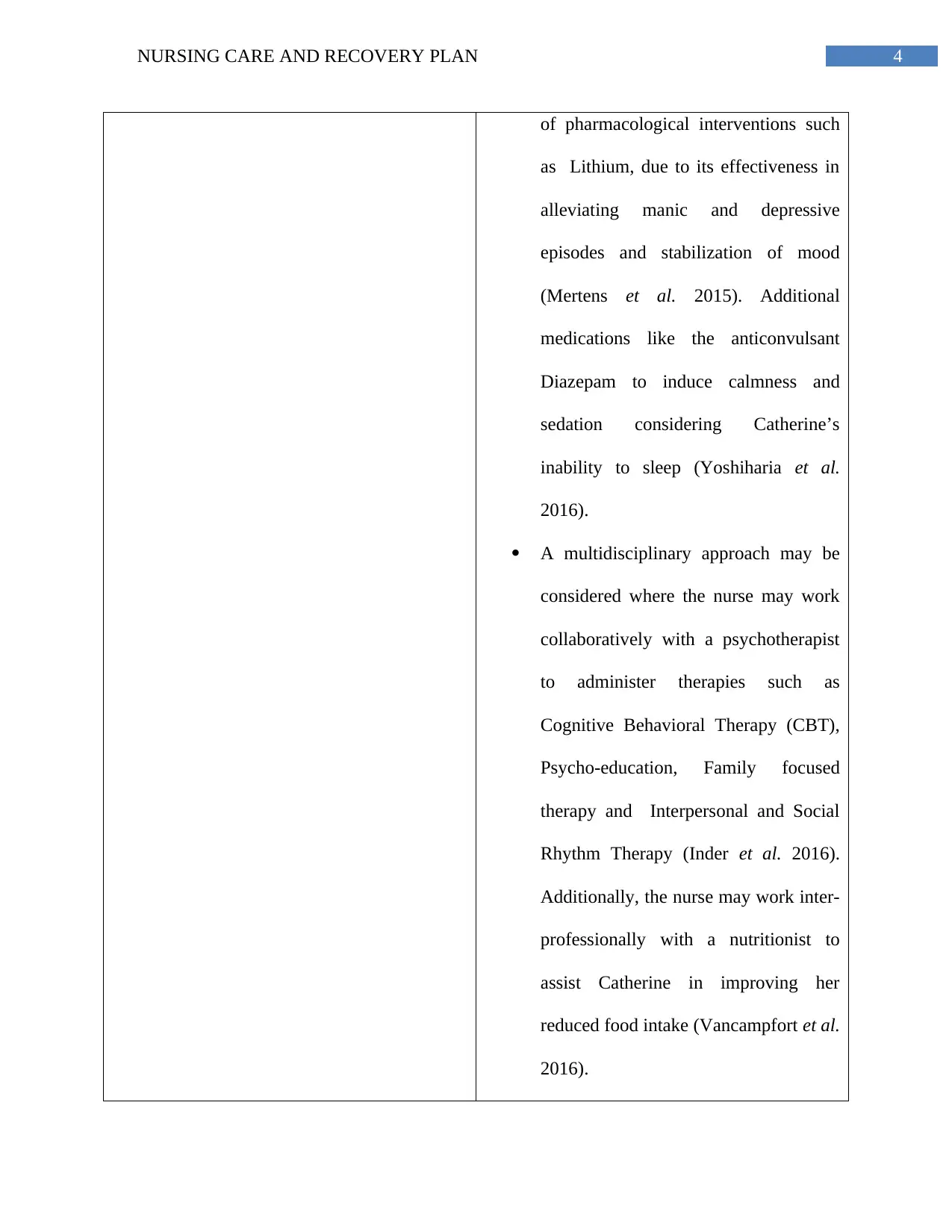
4NURSING CARE AND RECOVERY PLAN
of pharmacological interventions such
as Lithium, due to its effectiveness in
alleviating manic and depressive
episodes and stabilization of mood
(Mertens et al. 2015). Additional
medications like the anticonvulsant
Diazepam to induce calmness and
sedation considering Catherine’s
inability to sleep (Yoshiharia et al.
2016).
A multidisciplinary approach may be
considered where the nurse may work
collaboratively with a psychotherapist
to administer therapies such as
Cognitive Behavioral Therapy (CBT),
Psycho-education, Family focused
therapy and Interpersonal and Social
Rhythm Therapy (Inder et al. 2016).
Additionally, the nurse may work inter-
professionally with a nutritionist to
assist Catherine in improving her
reduced food intake (Vancampfort et al.
2016).
of pharmacological interventions such
as Lithium, due to its effectiveness in
alleviating manic and depressive
episodes and stabilization of mood
(Mertens et al. 2015). Additional
medications like the anticonvulsant
Diazepam to induce calmness and
sedation considering Catherine’s
inability to sleep (Yoshiharia et al.
2016).
A multidisciplinary approach may be
considered where the nurse may work
collaboratively with a psychotherapist
to administer therapies such as
Cognitive Behavioral Therapy (CBT),
Psycho-education, Family focused
therapy and Interpersonal and Social
Rhythm Therapy (Inder et al. 2016).
Additionally, the nurse may work inter-
professionally with a nutritionist to
assist Catherine in improving her
reduced food intake (Vancampfort et al.
2016).
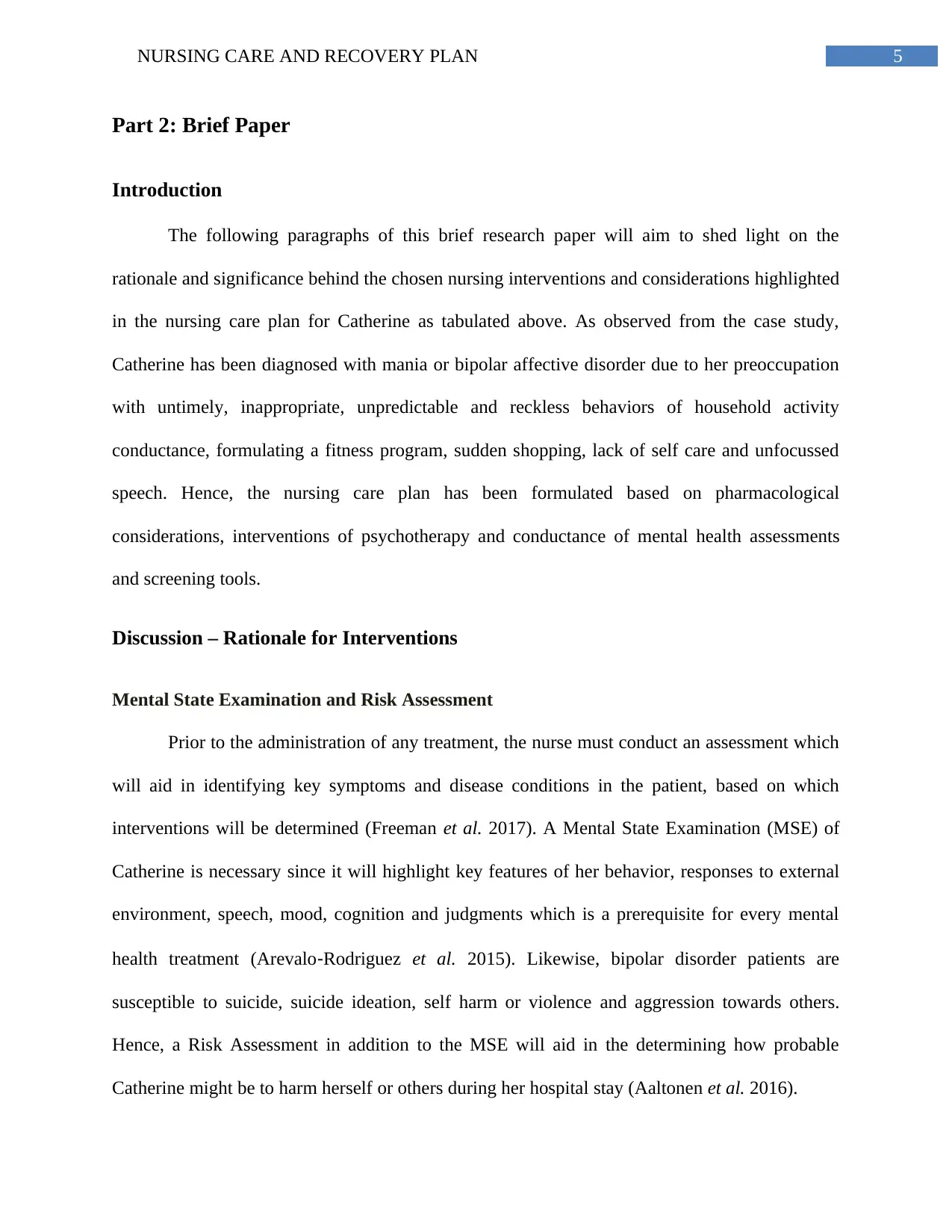
5NURSING CARE AND RECOVERY PLAN
Part 2: Brief Paper
Introduction
The following paragraphs of this brief research paper will aim to shed light on the
rationale and significance behind the chosen nursing interventions and considerations highlighted
in the nursing care plan for Catherine as tabulated above. As observed from the case study,
Catherine has been diagnosed with mania or bipolar affective disorder due to her preoccupation
with untimely, inappropriate, unpredictable and reckless behaviors of household activity
conductance, formulating a fitness program, sudden shopping, lack of self care and unfocussed
speech. Hence, the nursing care plan has been formulated based on pharmacological
considerations, interventions of psychotherapy and conductance of mental health assessments
and screening tools.
Discussion – Rationale for Interventions
Mental State Examination and Risk Assessment
Prior to the administration of any treatment, the nurse must conduct an assessment which
will aid in identifying key symptoms and disease conditions in the patient, based on which
interventions will be determined (Freeman et al. 2017). A Mental State Examination (MSE) of
Catherine is necessary since it will highlight key features of her behavior, responses to external
environment, speech, mood, cognition and judgments which is a prerequisite for every mental
health treatment (Arevalo‐Rodriguez et al. 2015). Likewise, bipolar disorder patients are
susceptible to suicide, suicide ideation, self harm or violence and aggression towards others.
Hence, a Risk Assessment in addition to the MSE will aid in the determining how probable
Catherine might be to harm herself or others during her hospital stay (Aaltonen et al. 2016).
Part 2: Brief Paper
Introduction
The following paragraphs of this brief research paper will aim to shed light on the
rationale and significance behind the chosen nursing interventions and considerations highlighted
in the nursing care plan for Catherine as tabulated above. As observed from the case study,
Catherine has been diagnosed with mania or bipolar affective disorder due to her preoccupation
with untimely, inappropriate, unpredictable and reckless behaviors of household activity
conductance, formulating a fitness program, sudden shopping, lack of self care and unfocussed
speech. Hence, the nursing care plan has been formulated based on pharmacological
considerations, interventions of psychotherapy and conductance of mental health assessments
and screening tools.
Discussion – Rationale for Interventions
Mental State Examination and Risk Assessment
Prior to the administration of any treatment, the nurse must conduct an assessment which
will aid in identifying key symptoms and disease conditions in the patient, based on which
interventions will be determined (Freeman et al. 2017). A Mental State Examination (MSE) of
Catherine is necessary since it will highlight key features of her behavior, responses to external
environment, speech, mood, cognition and judgments which is a prerequisite for every mental
health treatment (Arevalo‐Rodriguez et al. 2015). Likewise, bipolar disorder patients are
susceptible to suicide, suicide ideation, self harm or violence and aggression towards others.
Hence, a Risk Assessment in addition to the MSE will aid in the determining how probable
Catherine might be to harm herself or others during her hospital stay (Aaltonen et al. 2016).
⊘ This is a preview!⊘
Do you want full access?
Subscribe today to unlock all pages.

Trusted by 1+ million students worldwide
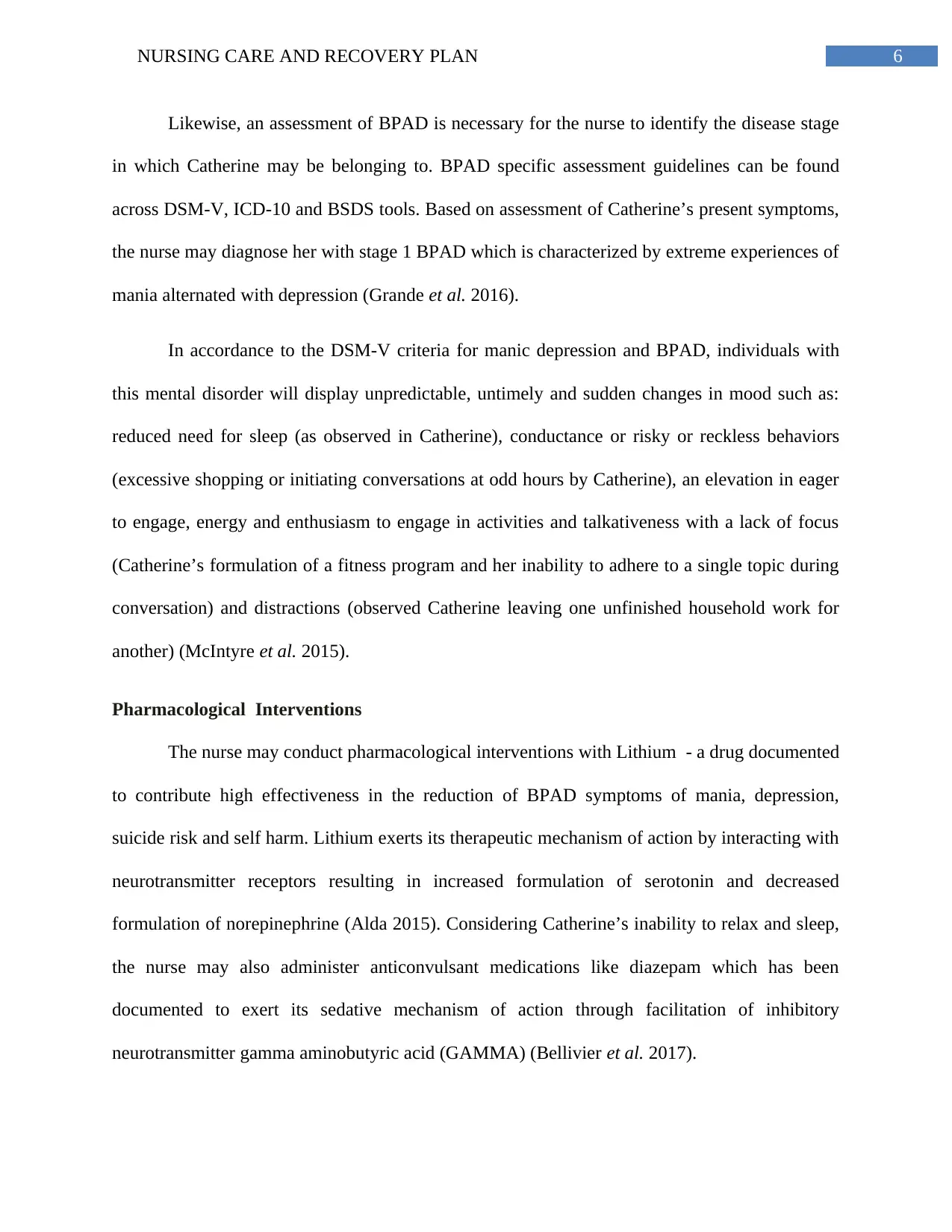
6NURSING CARE AND RECOVERY PLAN
Likewise, an assessment of BPAD is necessary for the nurse to identify the disease stage
in which Catherine may be belonging to. BPAD specific assessment guidelines can be found
across DSM-V, ICD-10 and BSDS tools. Based on assessment of Catherine’s present symptoms,
the nurse may diagnose her with stage 1 BPAD which is characterized by extreme experiences of
mania alternated with depression (Grande et al. 2016).
In accordance to the DSM-V criteria for manic depression and BPAD, individuals with
this mental disorder will display unpredictable, untimely and sudden changes in mood such as:
reduced need for sleep (as observed in Catherine), conductance or risky or reckless behaviors
(excessive shopping or initiating conversations at odd hours by Catherine), an elevation in eager
to engage, energy and enthusiasm to engage in activities and talkativeness with a lack of focus
(Catherine’s formulation of a fitness program and her inability to adhere to a single topic during
conversation) and distractions (observed Catherine leaving one unfinished household work for
another) (McIntyre et al. 2015).
Pharmacological Interventions
The nurse may conduct pharmacological interventions with Lithium - a drug documented
to contribute high effectiveness in the reduction of BPAD symptoms of mania, depression,
suicide risk and self harm. Lithium exerts its therapeutic mechanism of action by interacting with
neurotransmitter receptors resulting in increased formulation of serotonin and decreased
formulation of norepinephrine (Alda 2015). Considering Catherine’s inability to relax and sleep,
the nurse may also administer anticonvulsant medications like diazepam which has been
documented to exert its sedative mechanism of action through facilitation of inhibitory
neurotransmitter gamma aminobutyric acid (GAMMA) (Bellivier et al. 2017).
Likewise, an assessment of BPAD is necessary for the nurse to identify the disease stage
in which Catherine may be belonging to. BPAD specific assessment guidelines can be found
across DSM-V, ICD-10 and BSDS tools. Based on assessment of Catherine’s present symptoms,
the nurse may diagnose her with stage 1 BPAD which is characterized by extreme experiences of
mania alternated with depression (Grande et al. 2016).
In accordance to the DSM-V criteria for manic depression and BPAD, individuals with
this mental disorder will display unpredictable, untimely and sudden changes in mood such as:
reduced need for sleep (as observed in Catherine), conductance or risky or reckless behaviors
(excessive shopping or initiating conversations at odd hours by Catherine), an elevation in eager
to engage, energy and enthusiasm to engage in activities and talkativeness with a lack of focus
(Catherine’s formulation of a fitness program and her inability to adhere to a single topic during
conversation) and distractions (observed Catherine leaving one unfinished household work for
another) (McIntyre et al. 2015).
Pharmacological Interventions
The nurse may conduct pharmacological interventions with Lithium - a drug documented
to contribute high effectiveness in the reduction of BPAD symptoms of mania, depression,
suicide risk and self harm. Lithium exerts its therapeutic mechanism of action by interacting with
neurotransmitter receptors resulting in increased formulation of serotonin and decreased
formulation of norepinephrine (Alda 2015). Considering Catherine’s inability to relax and sleep,
the nurse may also administer anticonvulsant medications like diazepam which has been
documented to exert its sedative mechanism of action through facilitation of inhibitory
neurotransmitter gamma aminobutyric acid (GAMMA) (Bellivier et al. 2017).
Paraphrase This Document
Need a fresh take? Get an instant paraphrase of this document with our AI Paraphraser
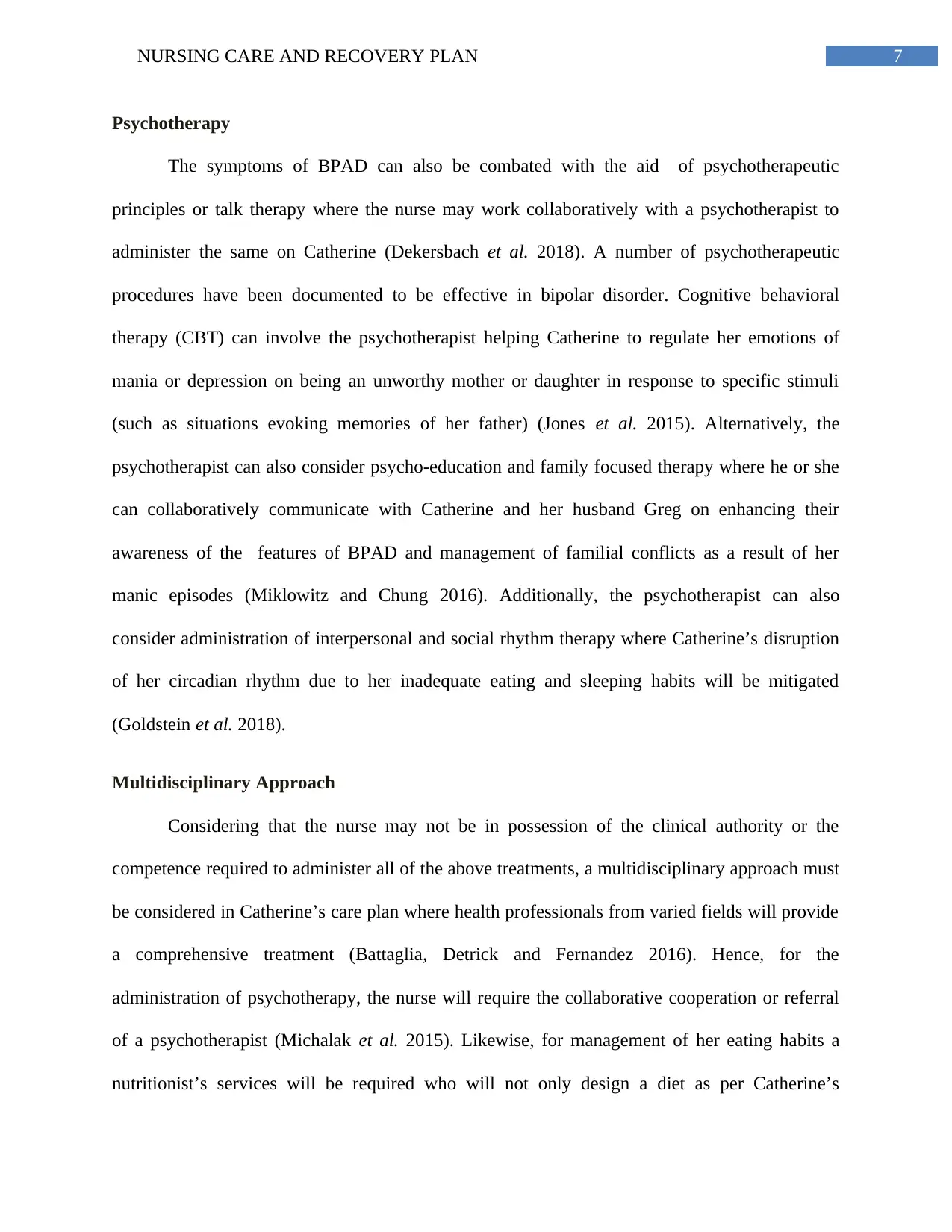
7NURSING CARE AND RECOVERY PLAN
Psychotherapy
The symptoms of BPAD can also be combated with the aid of psychotherapeutic
principles or talk therapy where the nurse may work collaboratively with a psychotherapist to
administer the same on Catherine (Dekersbach et al. 2018). A number of psychotherapeutic
procedures have been documented to be effective in bipolar disorder. Cognitive behavioral
therapy (CBT) can involve the psychotherapist helping Catherine to regulate her emotions of
mania or depression on being an unworthy mother or daughter in response to specific stimuli
(such as situations evoking memories of her father) (Jones et al. 2015). Alternatively, the
psychotherapist can also consider psycho-education and family focused therapy where he or she
can collaboratively communicate with Catherine and her husband Greg on enhancing their
awareness of the features of BPAD and management of familial conflicts as a result of her
manic episodes (Miklowitz and Chung 2016). Additionally, the psychotherapist can also
consider administration of interpersonal and social rhythm therapy where Catherine’s disruption
of her circadian rhythm due to her inadequate eating and sleeping habits will be mitigated
(Goldstein et al. 2018).
Multidisciplinary Approach
Considering that the nurse may not be in possession of the clinical authority or the
competence required to administer all of the above treatments, a multidisciplinary approach must
be considered in Catherine’s care plan where health professionals from varied fields will provide
a comprehensive treatment (Battaglia, Detrick and Fernandez 2016). Hence, for the
administration of psychotherapy, the nurse will require the collaborative cooperation or referral
of a psychotherapist (Michalak et al. 2015). Likewise, for management of her eating habits a
nutritionist’s services will be required who will not only design a diet as per Catherine’s
Psychotherapy
The symptoms of BPAD can also be combated with the aid of psychotherapeutic
principles or talk therapy where the nurse may work collaboratively with a psychotherapist to
administer the same on Catherine (Dekersbach et al. 2018). A number of psychotherapeutic
procedures have been documented to be effective in bipolar disorder. Cognitive behavioral
therapy (CBT) can involve the psychotherapist helping Catherine to regulate her emotions of
mania or depression on being an unworthy mother or daughter in response to specific stimuli
(such as situations evoking memories of her father) (Jones et al. 2015). Alternatively, the
psychotherapist can also consider psycho-education and family focused therapy where he or she
can collaboratively communicate with Catherine and her husband Greg on enhancing their
awareness of the features of BPAD and management of familial conflicts as a result of her
manic episodes (Miklowitz and Chung 2016). Additionally, the psychotherapist can also
consider administration of interpersonal and social rhythm therapy where Catherine’s disruption
of her circadian rhythm due to her inadequate eating and sleeping habits will be mitigated
(Goldstein et al. 2018).
Multidisciplinary Approach
Considering that the nurse may not be in possession of the clinical authority or the
competence required to administer all of the above treatments, a multidisciplinary approach must
be considered in Catherine’s care plan where health professionals from varied fields will provide
a comprehensive treatment (Battaglia, Detrick and Fernandez 2016). Hence, for the
administration of psychotherapy, the nurse will require the collaborative cooperation or referral
of a psychotherapist (Michalak et al. 2015). Likewise, for management of her eating habits a
nutritionist’s services will be required who will not only design a diet as per Catherine’s
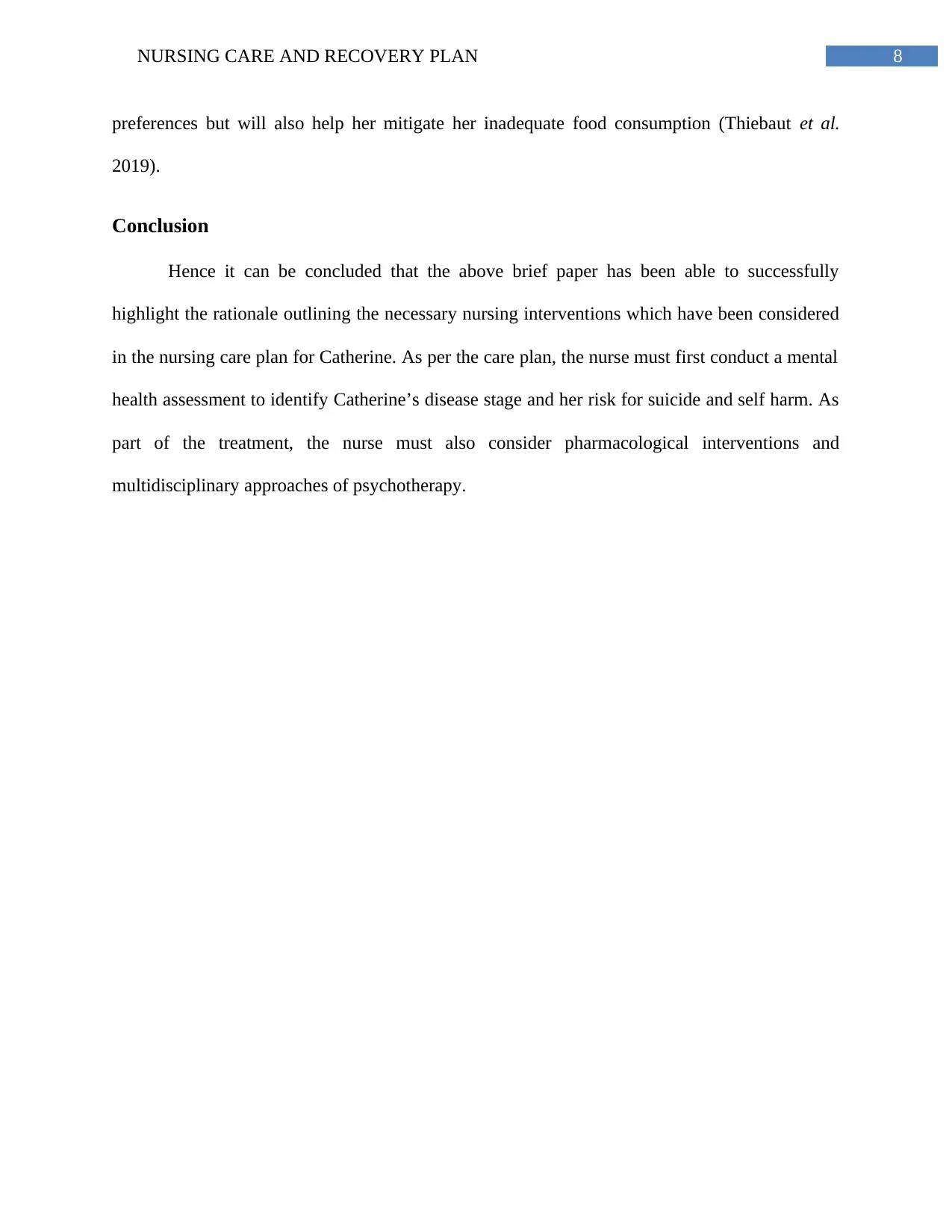
8NURSING CARE AND RECOVERY PLAN
preferences but will also help her mitigate her inadequate food consumption (Thiebaut et al.
2019).
Conclusion
Hence it can be concluded that the above brief paper has been able to successfully
highlight the rationale outlining the necessary nursing interventions which have been considered
in the nursing care plan for Catherine. As per the care plan, the nurse must first conduct a mental
health assessment to identify Catherine’s disease stage and her risk for suicide and self harm. As
part of the treatment, the nurse must also consider pharmacological interventions and
multidisciplinary approaches of psychotherapy.
preferences but will also help her mitigate her inadequate food consumption (Thiebaut et al.
2019).
Conclusion
Hence it can be concluded that the above brief paper has been able to successfully
highlight the rationale outlining the necessary nursing interventions which have been considered
in the nursing care plan for Catherine. As per the care plan, the nurse must first conduct a mental
health assessment to identify Catherine’s disease stage and her risk for suicide and self harm. As
part of the treatment, the nurse must also consider pharmacological interventions and
multidisciplinary approaches of psychotherapy.
⊘ This is a preview!⊘
Do you want full access?
Subscribe today to unlock all pages.

Trusted by 1+ million students worldwide
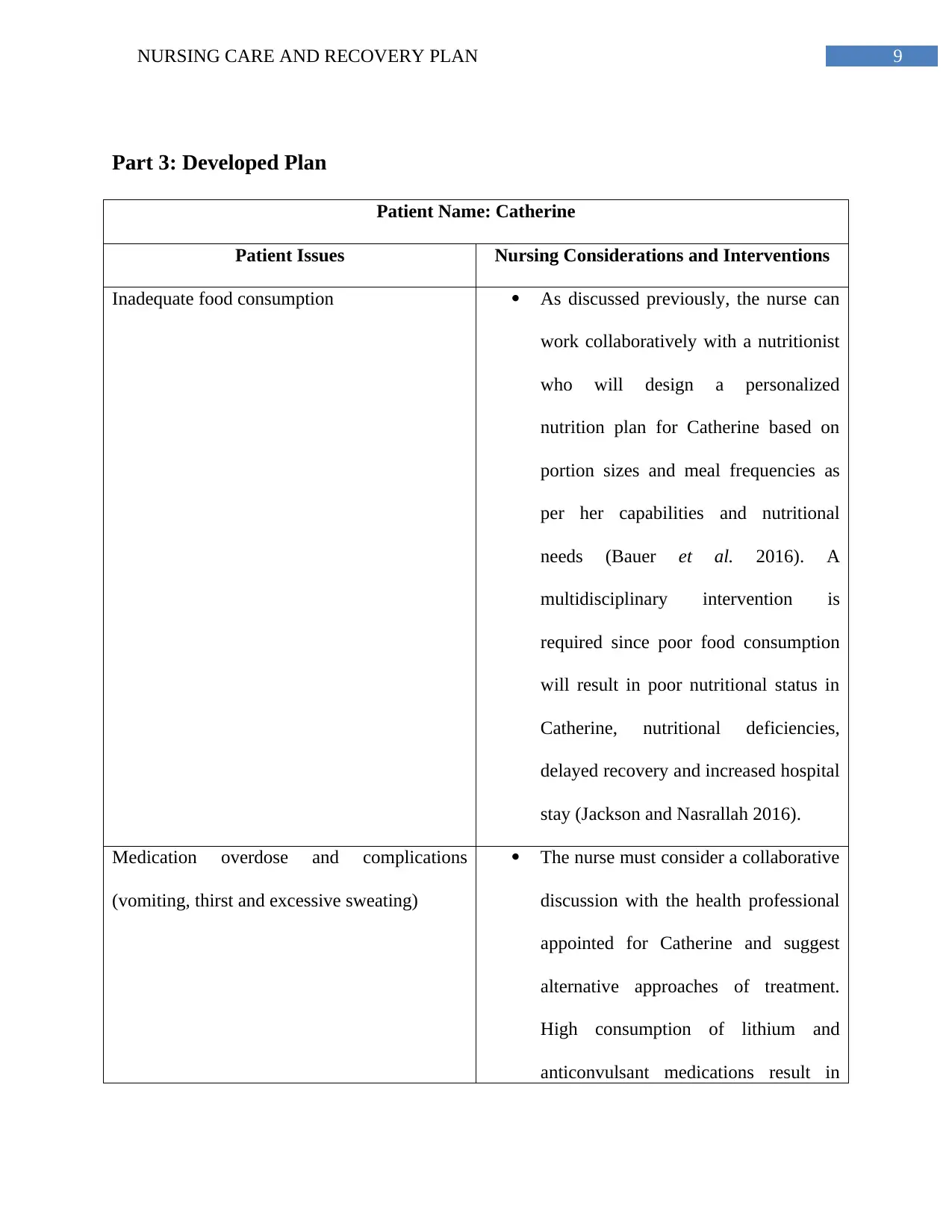
9NURSING CARE AND RECOVERY PLAN
Part 3: Developed Plan
Patient Name: Catherine
Patient Issues Nursing Considerations and Interventions
Inadequate food consumption As discussed previously, the nurse can
work collaboratively with a nutritionist
who will design a personalized
nutrition plan for Catherine based on
portion sizes and meal frequencies as
per her capabilities and nutritional
needs (Bauer et al. 2016). A
multidisciplinary intervention is
required since poor food consumption
will result in poor nutritional status in
Catherine, nutritional deficiencies,
delayed recovery and increased hospital
stay (Jackson and Nasrallah 2016).
Medication overdose and complications
(vomiting, thirst and excessive sweating)
The nurse must consider a collaborative
discussion with the health professional
appointed for Catherine and suggest
alternative approaches of treatment.
High consumption of lithium and
anticonvulsant medications result in
Part 3: Developed Plan
Patient Name: Catherine
Patient Issues Nursing Considerations and Interventions
Inadequate food consumption As discussed previously, the nurse can
work collaboratively with a nutritionist
who will design a personalized
nutrition plan for Catherine based on
portion sizes and meal frequencies as
per her capabilities and nutritional
needs (Bauer et al. 2016). A
multidisciplinary intervention is
required since poor food consumption
will result in poor nutritional status in
Catherine, nutritional deficiencies,
delayed recovery and increased hospital
stay (Jackson and Nasrallah 2016).
Medication overdose and complications
(vomiting, thirst and excessive sweating)
The nurse must consider a collaborative
discussion with the health professional
appointed for Catherine and suggest
alternative approaches of treatment.
High consumption of lithium and
anticonvulsant medications result in
Paraphrase This Document
Need a fresh take? Get an instant paraphrase of this document with our AI Paraphraser
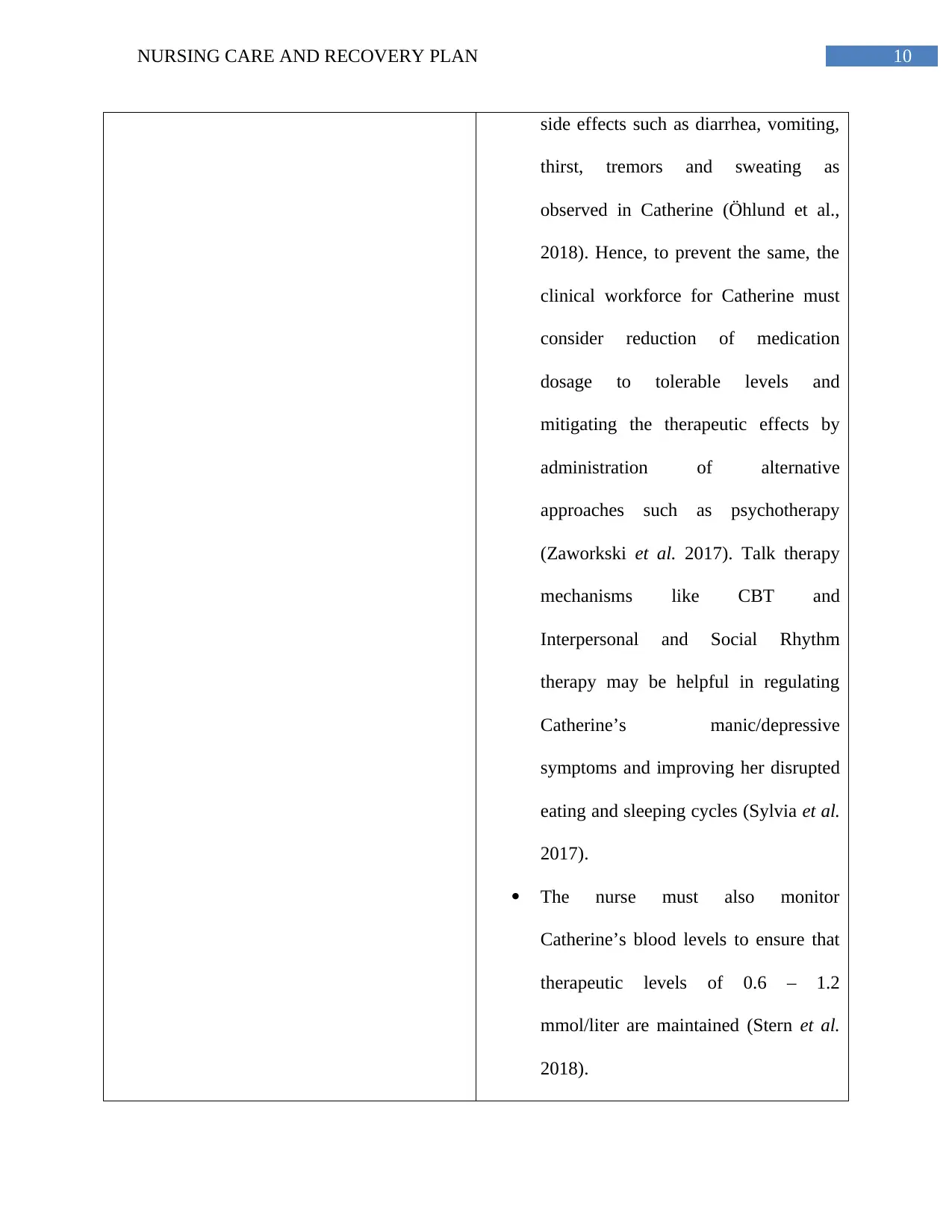
10NURSING CARE AND RECOVERY PLAN
side effects such as diarrhea, vomiting,
thirst, tremors and sweating as
observed in Catherine (Öhlund et al.,
2018). Hence, to prevent the same, the
clinical workforce for Catherine must
consider reduction of medication
dosage to tolerable levels and
mitigating the therapeutic effects by
administration of alternative
approaches such as psychotherapy
(Zaworkski et al. 2017). Talk therapy
mechanisms like CBT and
Interpersonal and Social Rhythm
therapy may be helpful in regulating
Catherine’s manic/depressive
symptoms and improving her disrupted
eating and sleeping cycles (Sylvia et al.
2017).
The nurse must also monitor
Catherine’s blood levels to ensure that
therapeutic levels of 0.6 – 1.2
mmol/liter are maintained (Stern et al.
2018).
side effects such as diarrhea, vomiting,
thirst, tremors and sweating as
observed in Catherine (Öhlund et al.,
2018). Hence, to prevent the same, the
clinical workforce for Catherine must
consider reduction of medication
dosage to tolerable levels and
mitigating the therapeutic effects by
administration of alternative
approaches such as psychotherapy
(Zaworkski et al. 2017). Talk therapy
mechanisms like CBT and
Interpersonal and Social Rhythm
therapy may be helpful in regulating
Catherine’s manic/depressive
symptoms and improving her disrupted
eating and sleeping cycles (Sylvia et al.
2017).
The nurse must also monitor
Catherine’s blood levels to ensure that
therapeutic levels of 0.6 – 1.2
mmol/liter are maintained (Stern et al.
2018).
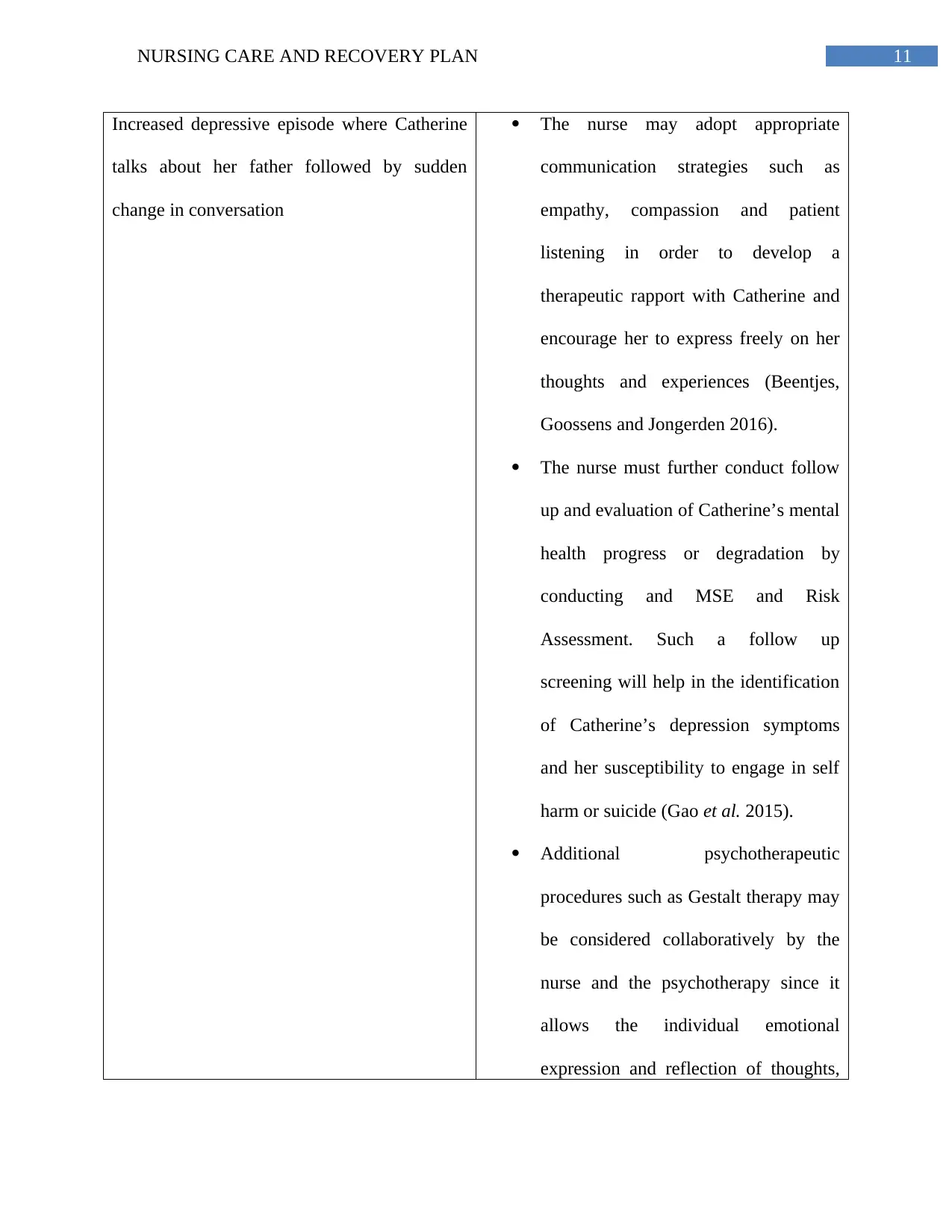
11NURSING CARE AND RECOVERY PLAN
Increased depressive episode where Catherine
talks about her father followed by sudden
change in conversation
The nurse may adopt appropriate
communication strategies such as
empathy, compassion and patient
listening in order to develop a
therapeutic rapport with Catherine and
encourage her to express freely on her
thoughts and experiences (Beentjes,
Goossens and Jongerden 2016).
The nurse must further conduct follow
up and evaluation of Catherine’s mental
health progress or degradation by
conducting and MSE and Risk
Assessment. Such a follow up
screening will help in the identification
of Catherine’s depression symptoms
and her susceptibility to engage in self
harm or suicide (Gao et al. 2015).
Additional psychotherapeutic
procedures such as Gestalt therapy may
be considered collaboratively by the
nurse and the psychotherapy since it
allows the individual emotional
expression and reflection of thoughts,
Increased depressive episode where Catherine
talks about her father followed by sudden
change in conversation
The nurse may adopt appropriate
communication strategies such as
empathy, compassion and patient
listening in order to develop a
therapeutic rapport with Catherine and
encourage her to express freely on her
thoughts and experiences (Beentjes,
Goossens and Jongerden 2016).
The nurse must further conduct follow
up and evaluation of Catherine’s mental
health progress or degradation by
conducting and MSE and Risk
Assessment. Such a follow up
screening will help in the identification
of Catherine’s depression symptoms
and her susceptibility to engage in self
harm or suicide (Gao et al. 2015).
Additional psychotherapeutic
procedures such as Gestalt therapy may
be considered collaboratively by the
nurse and the psychotherapy since it
allows the individual emotional
expression and reflection of thoughts,
⊘ This is a preview!⊘
Do you want full access?
Subscribe today to unlock all pages.

Trusted by 1+ million students worldwide
1 out of 21
Related Documents
Your All-in-One AI-Powered Toolkit for Academic Success.
+13062052269
info@desklib.com
Available 24*7 on WhatsApp / Email
![[object Object]](/_next/static/media/star-bottom.7253800d.svg)
Unlock your academic potential
Copyright © 2020–2025 A2Z Services. All Rights Reserved. Developed and managed by ZUCOL.





